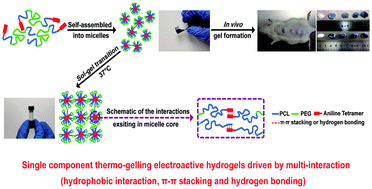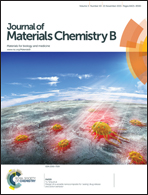Single component thermo-gelling electroactive hydrogels from poly(caprolactone)–poly(ethylene glycol)–poly(caprolactone)-graft-aniline tetramer amphiphilic copolymers
Abstract
Injectable biodegradable and conductive hydrogels have great potential applications in the regeneration of soft tissues sensitive to electrical signals. Herein, we have developed a series of injectable conductive hydrogels using a single component copolymer poly(caprolactone)–poly(ethylene glycol)–poly(caprolactone) (PCEC) grafted aniline tetramer (AT) via a thermo-gelling approach. The chemical structure, thermal property, and electrochemical property of the amphiphilic copolymer PCEC–AT, and the multi-interactions, morphologies, swelling ratio, dynamic mechanical property, and gelation time of the hydrogels from PCEC–AT were characterized. Injectability of the in situ forming electroactive hydrogels was verified by in vivo subcutaneous injection into a Sprague-Dawley rat. The cytotoxicity of the PCEC–AT conductive copolymers was evaluated by culturing C2C12 myoblasts with the copolymers, and all the samples showed no cytotoxicity, suggesting the good cytocompatibility of the injectable hydrogels. These injectable biodegradable and conductive hydrogels with good biocompatibility are promising candidates for the repair of soft tissues where electrical signals are needed.


 Please wait while we load your content...
Please wait while we load your content...